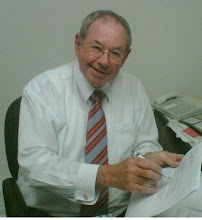RetireLaughing Newsletter Feb. 2006
Hi this is Bernard Kelly again at www.retirelaughing.com
In this post I'll show you how property investment actually works.
To simply this example, I'll assume that you have 20 years to build your portfolio, and that you want to achieve a passive income of $50,000 p.a. for your retirement.
Of course, most of us don't have 20 years, and indeed you could achieve six investments in less time, but you'll get the idea as you work through this case study.
So let's start.
Let's assume that in 1984, an investor paid $70,000 for their first investment property, funded 100% on an interest only basis. (Or rather, this is how you would typically fund investment properties today). The rental income was then $2800 - 4%. This $70,000 was the median price in Melbourne at the time for a suburban three bedroom home.
A few years later, perhaps around 1987 or 1988, they realised that their first IP had increased to $92,000 so they decided to use that $22,000 of increased equity ($92,000 less that original $70,000) and acquire a second. This second investment obviously cost $ 92,000 which they again funded on the basis of 100% interest only. The rental yield remained at 4%, so they now had two rental streams.
In 1991, the median price for a three bedroom suburban family home in Melbourne had increased to $149,000 and at that time our investors purchased their third. Same funding, same yield, but now their rental income was 3 X $5960 i.e. a total of $17,880. This increased cash flow improves their negotiating power.
Then we had "the recession that we had to have" - to quote Paul Keating, and house prices fell. Over the next few years the median price of a three bedroom family home in Melbourne had fallen to $145,000 - it dipped just 3% - before it recommenced its remorseless climb. It was in this market that our investors purchased their fourth investment. Same funding, same yield, and now they had rental income of 4 X $5800 for a total of $23,200 p.a.
A few years later - in 1998 - they put their fifth in place when the values had increased to $198,000 and finally in 2001-2002 they put their sixth in place for $300,000 and their rental income had become 6 X $12,000 or $72,000 p.a.
It's now 2006, and they elect to exit the workforce.
What have they got for 21 years of investing? Well they now have six investments each worth $360,000 (that's $2,160,000 in total) but they still have all those interest-only loans of $954,000.
One option they now have would be to sell investments sufficient to eliminate that debt of $954,000. This would leave them with assets of $1,206,000.
And at a 4% yield, their income in retirement would be $48,240.
That's it. Simple isn't it?
The example shows actual median house prices for Melbourne, and so after buying investments at quite a leisurely pace (every third or fourth year), after 21 years our investors have acquired six investments.
This is how property investment works.
Now if you had done something like this years ago, and you already had that passive income, would we be talking today?
You can of course adjust these figures for Capital Gains Tax, but you get the point, don't you? (In fact, the maximum rate of capital gains tax is 48.5%, on HALF of your gain. Now the marginal tax rate on an income of $50,000 is 30%, so the capital gains tax for these investors is 30% on HALF their gain i.e. they pay only 15% of the total gain.)
Now if you had done something like this years ago, and you already had that passive income, would we be talking today?
We can't afford to delay getting started, can we?
Phone me today!
Bernard Kelly 0414 778 518 www.retirelaughing.com

